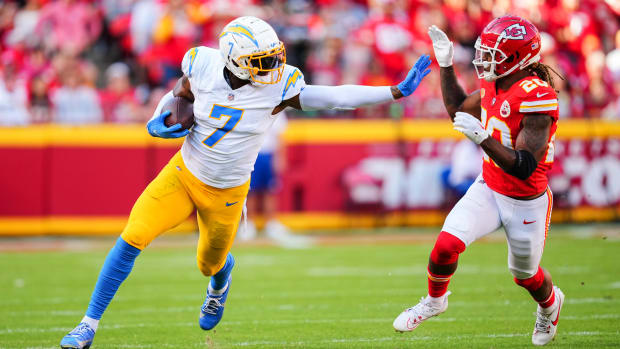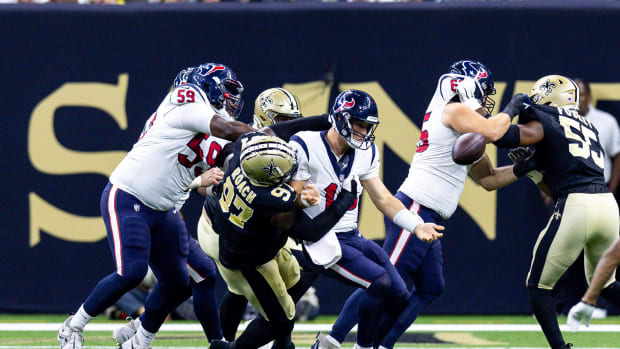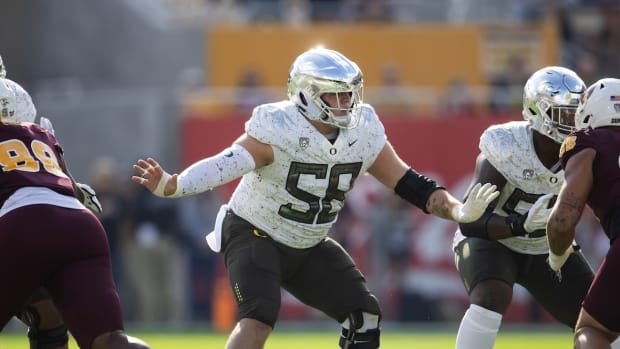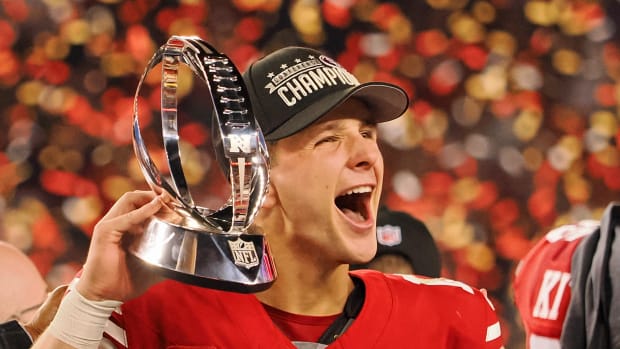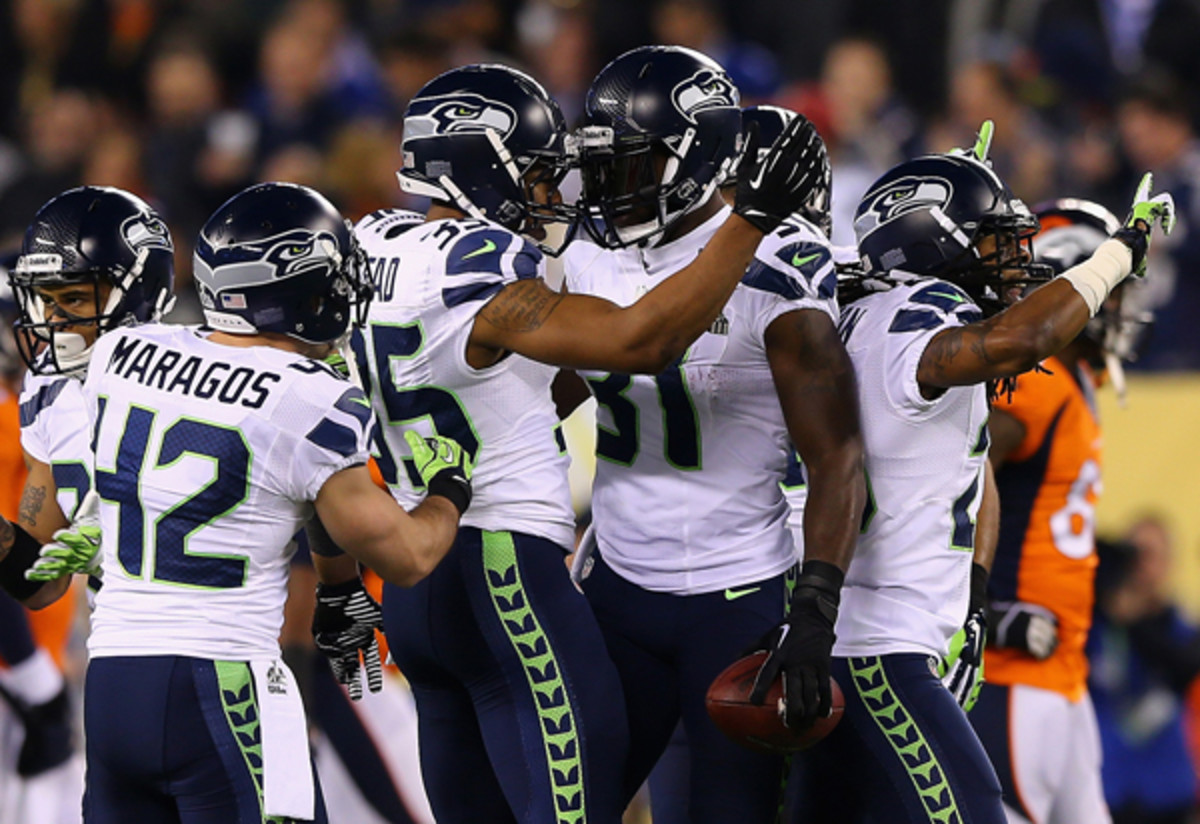
The All-22: Seattle's defensive effort was historic ... and will be hard to replicate
The Legion of Boom is a rare entity. (Elsa/Getty Images)
"People don't understand us. They're kind of used to normal. Well, we're the new normal." -- Earl Thomas
In a league defined by the passing game more and more every year, it was anything but normal. Through the 2013 regular season, Peyton Manning led the most prolific offense in NFL history, scoring 606 points and overpowering opponents with as compelling an array of targets as you'll ever see. And then, Manning's Broncos came to MetLife Stadium to face Thomas and the rest of the Seahawks' defense. And that's where it all ended.
Seattle's 43-8 thrashing of the Broncos in Super Bowl XLVIII was the perfect and ultimate distillation of the defensive philosophy Pete Carroll brought with him from USC when he became Seattle's head coach in January 2010. The Seahawks pitched the first first-half shutout since the Ravens did it to the Giants in Super Bowl XXXV. The Seahawks shut the Broncos out through three quarters, the first time that's happened since the Steelers did it to the Vikings in Super Bowl IX.
Manning completed 34 of 49 passes for 280 yards with one touchdown and two interceptions, but the game was out of hand before the first half was over, so his surface stats were little more than spackle -- they don't tell the story of Seattle's historic dominance. This was the first time since the divisional round of the 2004 season that a Manning-led team not resting its starters was held to fewer than 10 points. Manning averaged 8.2 yards per completion; the league average in 2013 was 11.6. Demaryius Thomas set a Super Bowl record with 13 catches, but most came during the definition of garbage time: Just five were good for a first down, seven went for fewer than 10 yards and one was fumbled away. On the biggest stage imaginable, this was a 1970s-style defensive beatdown in a new-millennium league, which makes it as impressive as any single-game defensive performance in the sport -- in any year.
Now, everyone is talking about how to replicate Seattle's defensive philosophy and personnel, just as they were when the Steel Curtain, the 1980s Bears and the Ravens during Ray Lewis' heyday did their thing. And, as was the case then, putting together this kind of defense in one offseason is about as likely as opening a box of Cap'n Crunch and finding the Hope Diamond at the bottom. You'll hear a lot this spring and summer about rotational defensive linemen and big, physical cornerbacks and linebackers who can cover with speed through the half and safeties who can play everywhere. Just remember, buying a Stratocaster doesn't make you Jimi Hendrix.
Asked two days after the Super Bowl if his team should aspire to put together a defense like Seattle's, Packers quarterback Aaron Rodgers was effusive in his praise. "Well, with all due respect, I don't think it's possible to play at that level for many other teams in this league. If any," he said. "That's a talented group that's one of the best that's been around the league for a long time. I don't think that should be our goal. We need to improve on both sides of the ball, but that team has a unique mixture of secondary talent that's as good a group in the league as you're going to see, and a front seven that really plays well together."
And that's the reality of the situation. Seattle's defense was created over time, with an unyielding vision that mixed old-school and new-school principles to perfection.
Let's take a look at what it did to the Broncos.
"Yeah, anytime, man. I want anybody one-on-one in the slot. Anytime." -- Wes Welker, during Super Bowl Media Day
"Don't you ever say you want one-on-ones with us! Don't you ever say that!" -- Richard Sherman to Welker in Super Bowl XLVII
Well, nobody wanted those one-on-one matchups. Seattle's strategy against the Broncos was clear -- take away Manning's opportunities for the deep ball with pressure and tight coverage, leaving shorter passes open -- but it wasn't simple. Those shorter completions were punishable offenses; Seahawks' defenders closed in on the quick stuff all evening and left a haymaker for every underneath completion. To that end, Seattle frequently used safety Kam Chancellor as a lurk defender, sticking at linebacker depth or just behind, while a defensive lineman dropped into coverage to further muddy Manning's looks.
It wasn't the first time Seattle did this in 2013, and it wasn't the first time it worked. When the Seahawks welcomed the Saints to CenturyLink Field on Dec. 2, Drew Brees completed 23 of 38 passes for 147 yards and a touchdown. He went 0 for 8 on attempts that traveled at least 15 yards in the air. That was because Seattle sped up time on his long reads, brought headaches on anything else and showed more looks than those categorizing this defense as "simple" would have you believe. Brees' incomplete pass to tight end Jimmy Graham with 5:48 remaining in the first quarter serves as an excellent example.
Chancellor (31) is just behind the left side of the line, to the left of defensive end Red Bryant. He backed off into short coverage in case the right side tight end in New Orleans' two-tight end, six-offensive lineman formation was a target. However, Graham was the target on the other side, and it was outside linebacker Bruce Irvin who followed Graham in coverage on the out route, after he first keyed in on the running back. Irvin was selected in the first round of the 2012 draft as a defensive end, but the Seahawks moved him to outside linebacker before the 2013 season, forcing him to learn coverage concepts for the first time. Irvin came over and leveled Graham near the sideline, timing his hit perfectly to jar the ball loose for the incompletion.
And it wasn't just the fast guys who stopped Denver's short passes. With 8:10 left in the first half, after a Manning deep pass to Demaryius Thomas missed its target, the Broncos faced second-and-10 from their own 40-yard line. This time, Manning attempted a quick screen to running back Montee Ball, with fairly dismal results. The instigators were actually Seattle's two defensive tackles, Michael Bennett (72) and Clinton McDonald (69), who broke off with surprising speed to stop the play from where they were. Bennett bounced off a spin move he gave left guard Zane Beadles, while McDonald shot to his left from a block by right guard Louis Vasquez. They arrived at the same time to stop Ball for a one-yard gain. Just as important, though, was the way right cornerback Byron Maxwell and slot cornerback Walter Thurmond performed a coverage switch when Welker and Eric Decker tried a crossing concept from the snap. Sherman had Andre Caldwell on lock on the other side. For Broncos fans, the most frustrating aspect of this play, upon further review, will undoubtedly be that tight end Julius Thomas was roaming through the middle of Seattle's coverage, basically wide open.
It wasn't the first -- or last -- time Manning would miss an opportunity.
At the end of that drive, with 3:36 remaining in the first half, Manning threw the interception that linebacker and eventual Super Bowl MVP Malcolm Smith returned for a 69-yard touchdown. The Broncos went trips left to break up Seattle's coverage, and it would have worked had defensive end Cliff Avril not disrupted Manning's throw with his pass rush, causing Manning to throw a duck to running back Knowshon Moreno that Smith easily jumped. Throughout the game, Denver ran picks underneath, but Manning didn't exploit the advantages he should have gained by picking apart the Seahawks' coverage against bunched and grouped formations. In its Week 5 loss to the Colts, Seattle was vexed by Andrew Luck's ability to drive the ball to his receivers out of trips and bunch. It was ironic (and probably stinging) that Manning's successor in Indy had that on lock, while Manning did not.
Of course, even when Manning did use bunch to break up coverage, it didn't quite work. With 6:08 left in the third quarter and Denver already trailing 29-0, Demaryius Thomas ran a deep crossing route from the far side of bunch right. Chancellor (red box) was playing at lurk depth, and this play actually exposed a weakness in lurk coverage -- when Chancellor ran up the seam, he gave Thomas a free release across, providing Thomas with a nice, big pocket in the middle of Seattle's defense. Thomas caught the ball and tried to stiff-arm Maxwell to gain extra yardage. But Maxwell stripped him, Smith recovered the fumble and right tackle Orlando Franklin added a 15-yard unneccessary roughness penalty to put the Seahawks back in business from their own 42-yard line. When Russell Wilson hit Jermaine Kearse for a 23-yard touchdown six plays later, the margin increased to 36-0.
The carnage was just about complete. After the game, Sherman added insult to injury by intimating the Broncos were giving away even more than they originally thought.
"All we did was play situational football,” he told Robert Klemko of TheMMQB.com. “We knew what route concepts they liked on different downs, so we jumped all the routes. Then we figured out the hand signals for a few of the route audibles in the first half.”
“You know, it looked like it," Broncos head coach John Fox said the next day. "But I think it’s more that they’re very good players. I don’t know that there are any mystery things. You’d have to ask [Manning]. But they’re a good football team. And I think it was more about them executing and playing very well than any other stuff.”
Thus, the template was set. Any number of teams will now try to mirror it. But the architect avoided any notion that his house was complete. Asked on Monday to put his defense in historical context, Carroll wisely deferred.
"Just so my guys hear this, I don’t want to take any shots at our guys that we’re this or we’re that or whatever, or we’re not this or that. I don’t know how to answer that question. I think you look back years down the road, and you access what you accomplished with a group. You can take account of it then. I think when you’re in the middle of it, it’s not time to talk that way. We don’t know. We put together a couple of good seasons, back-to-back really big-time seasons in scoring and playing good, solid defense in a similar fashion. That’s pretty cool. When the names of the teams and the years of [the all-time best defenses] come up, you have many big-time defenses that have played. We’ll see. You have to look back, I think, and evaluate rather than call it right now. You won’t get me doing that.”
So that's fair warning, NFL. The Seahawks believe their defense can be even better in 2014. And they just might be right.
[si-nfl-player id="ef6ace11123e4934bffa47bc523a8a58














































